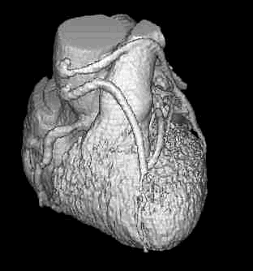EBA vs. Conventional Coronary Angiography
Numerous studies published in the peer reviewed medical journals over the past several years have demonstrated that electron beam CT coronary angiography (EBA) is an acceptable alternative to cardiac catheterization in many clinical situations. EBA can successfully image the coronary arteries in 93% of patients with more than 80% of the coronary artery segments being analyzable. The location distribution of the 20% of the coronary artery segments that are unanalyzable is 8% proximal, 22% middle and 70% distal. EBA has an 80-85% sensitivity and 90-95% specificity for detecting significant coronary stenosis in the proximal 2/3 of the coronary vasculature.
The accuracy for detecting coronary stenosis is highest in the left main artery and left anterior descending artery and lowest in the circumflex artery. The sensitivity and specificity detecting patency of coronary bypass grafts using EBA is 95-100% and 89-100% respectively. EBA can also be very helpful detecting restenosis in patients with recurrent chest pain within the restenosis window after percutaneous coronary interventions and in localizing the coronary sinus in advance of cardiac pacemaker placement.
Angiography of other Vascular Systems
In addition to the coronary vasculature, the Electron Beam CT scanner is capable of performing high quality 3D angiograms of the peripheral arterial system including the aorta (for aneurysm or dissection), the carotid arteries, the pulmonary arteries and the renal arteries.

